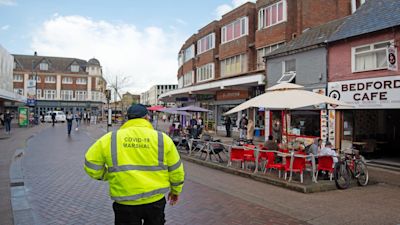Covid: Early signs infection levels are creeping up in England as R number increases

There are "early signs" Covid infection levels are increasing in England, although rates remain low, the Office for National Statistics (ONS) has said.
The results from the infection survey come as England's R number has increased slightly to between 0.9-1.1, according to the Department of Health.
The latest growth rate in England of between -2% and 1% which means that the number of new infections is broadly flat or shrinking by up to 2% every day.
An R value of between 0.9 and 1.1 means that, on average, every 10 people infected will pass Covid-19 on to nine and 11 other people.
R value for regions in England:
England - 0.9 to 1.1East of England - 0.8 to 1.1London - 0.9 to 1.1Midlands - 0.8 to 1.0North East and Yorkshire - 0.8 to 1.0North West - 0.9 to 1.2South East - 0.8 to 1.0South West - 0.8 to 1.1
Around one in 1,110 people in private households in England had Covid-19 in the week to May 15 – up from one in 1,340 the previous week, according to the latest ONS estimates.
Yorkshire and the Humber had the highest proportion of people of any region in England likely to test positive for coronavirus in the week to May 15: around one in 520.
A new coronavirus variant has been identified by Public Health England, which is mainly concentrated in Yorkshire and the Humber.
The variant, VUI-21MAY-01, has been designated as a Variant Under Investigation by PHE, and was discovered by a team at Sheffield University and Sheffield Teaching Hospitals.
There have been 49 cases across the country to date - the team in Sheffield are currently sequencing other positive tests from hospitals in the region to ensure local teams have up-to-date information on the virus.
There is currently no evidence that this variant causes more severe disease or renders the vaccines currently deployed any less effective.
New coronavirus variant identified mainly concentrated in Yorkshire and the Humber
Where can I go on holiday and what regulations remain in place?
In the North East, it was one 840 and in the South East it was one in 1,210. However, the South West had the lowest estimate at around one in 2,730.
The trend was uncertain for all other regions in the same week, the ONS said, before adding rates were low in all regions and credible intervals were wide.
The latest data comes amid increasing concern in government at the spread of the Indian variant.
Listen to our latest coronavirus podcast:
Meanwhile, in Wales, the percentage of people testing positive for Covid-19 remained low in the week ending May 15, 2021.
Around one in 4,340 people in private households in Wales had Covid-19 in the week to May 15.
Covid infection levels also remained low in Scotland where around one in 1,960 people in private households in the country had Covid-19 in the week to May 15.
In Northern Ireland, around one in 1,550 people in private households in the country had Covid-19 in the week to May 15.
Sarah Crofts, Head of Analytical Outputs for the COVID-19 Infection Survey, said there has been a "mixed picture of infection levels" across the UK.
Ms Crofts said: "Although we have seen an early indication of a potential increase in England, rates remain low and it is too soon to say if this is the start of a trend.
"When rates are low they can change direction more easily, so it is crucial that we continue to monitor infection rates as restrictions are lifted and people are able to socialise more widely."